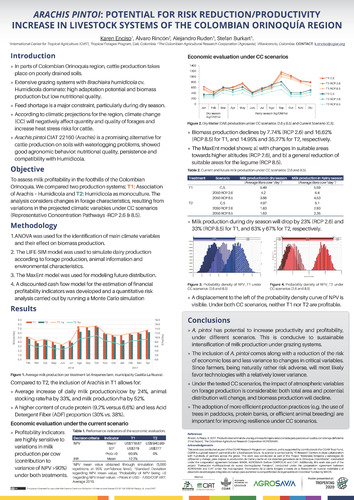Arachis pintoi: Potential for risk reduction/productivity increase in livestock systems of the Colombian Orinoquía region
Abstract
In parts of the foothills of the Colombian Orinoquía region, bovine livestock production takes place on poorly drained soils. The region is dominated by extensive grazing systems with Brachiaira humidicola cv. Humidicola. This grass has shown high adaptation potential under temporal waterlogging conditions. However, despite maintaining high yields in terms of biomass, its nutritional quality is low. In many cases, inadequate management practices and low soil fertility result in degradation. As a result of this, a lack of feed is a major constraint in the Orinoquía, particularly during dry season. According to climatic projections for the region, annual precipitation and maximum temperatures will increase and this will negatively affect quantity and quality of forages and increase waterlogging risks. Against this background, AGROSAVIA, in 2013, started agronomic evaluations of forage legumes. They selected Arachis pintoi CIAT 22160 (Arachis) as promising alternative for livestock production on soils with waterlogging problems. It showed good agronomic behavior in terms of nutritional quality, persistence and compatibility with grasses such as Humidicola. Based on the agronomic evaluations, this study assesses milk profitability in the foothills of the Colombian Orinoquía from an economic perspective. We compared two production systems: T1, the association Arachis – Humidicola and T2, Humidicola as monoculture. We used a cashflow model and risk assessment under a Montecarlo simulation model to estimate economic indicators. The projections for economic returns consider changes in forage characteristics for both treatments, resulting from variations in the projected climatic variables under different climate change scenarios for the region RCP (2:6, 4.5, & 8.5). The LIFE-SIM model was used to simulate dairy production according to forage production, animal information and environmental characteristics. Results show that T1 incremented animal productivity by 11%, among others. T1 also results in better grass persistence due to higher nitrogen (N) levels in soil resulting from the association with the legume. The legume also provides positive impacts on soil structure and composition. This helps improving the adaptation capacity of the system. Finally, producer incomes could increase as a result of lower vulnerability to (climate) risks and reduced production costs (due to lower N fertilizer use).

